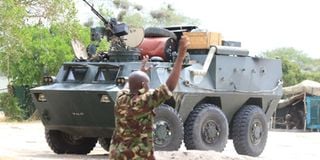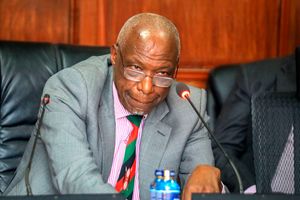Premium
Call for change as war enters year 10

A Kenyan soldier who is part of the African Union Mission in Somalia is pictured at a base on February 11, 2017.
What you need to know:
- The military personnel have called for a review of approach, saying the use of bullets and bombs is proving ineffective against a group powered by an ideology that is more than a millennium old.
Soldiers from Amisom 10 Battle Group will replace Amisom Nine group, which has been in Somalia for a year.
Senior military personnel and soldiers who have faced al-Shabaab have been pushing for a change of strategy in the war in Somalia, which enters its tenth year today.
The military personnel have called for a review of approach, saying the use of bullets and bombs is proving ineffective against a group powered by an ideology that is more than a millennium old.
The Saturday Nation has established that discussions on change of strategy have been embraced by the top brass at the Department of Defence, with commanders keen to rely more on civil military engagement in defeating the terrorist group blamed for carrying out attacks in Kenya.
This comes as the last batch of Kenya Defence Forces (KDF) soldiers is expected to leave for Somalia from the start of next month.
The soldiers have been training in parts of Isiolo and Samburu counties for the last six months in preparation for what is expected to be the last deployment of KDF in Somalia.
KDF and the other African Union Mission in Somalia (Amisom) soldiers are expected to leave the Horn of African country in the next one year, according to the Somali Transition Plan.
Senior military officers who did not wish to be named said the withdrawal is, however, conditional.
Amisom 10 Battle Group
Soldiers from Amisom 10 Battle Group will replace Amisom Nine group, which has been in Somalia for a year.
The current deployment is under the command of Brigadier Paul Njema.
The Somali Transition Plan is aimed at the gradual handover of security responsibilities to the country’s institutions.
The development of a Concept of Operations (CONOPs) 2018-21 provides an outline for the implementation of the plan. Amisom is expected to close down operations next year.
“It is expected to provide a comprehensive basis for conducting operations in including the training and mentoring of the Somali Police and the national army, while at the same time creating a useful framework for stabilisation, civil military activities, early recovery and reconstruction,” Amisom Force spokesperson Lt-Col Charles Imbiakha said.
In preparing for the KDF withdrawal, the government has been strengthening the Border Security Command.
This unit was established in 2016 to stop the infiltration of al-Shabaab terrorists into the country.
President Uhuru Kenyatta appointed Maj-Gen William Shume to lead the Border Security Command in April, taking from Maj-Gen Thomas Chepkuto who has since retired.
Civic-military engagements
Kenya shares a 684-kilometre long border with Somalia.
It has remained porous, communities living near affected by explosive and other attacks.
Nairobi, Mombasa and several towns have also been attacked in recent years. In the past few months, KDF has intensified civic-military engagements.
The Saturday Nation has learnt that Department of Defence has asked for financial support from the National Treasury, saying such activities are the next frontier in dealing with terrorism, extremism and radicalisation.
Civic military engagements include drilling boreholes, building of classrooms, upgrading roads and supporting farming activities in places that are known for radicalisation.
The activities are being carried out in Kenya and Somalia, the military says.
Kenyan soldiers crossed into Somalia on the night of October 16, 2011 in an operation dubbed Linda Nchi.
The Linda Nchi operation key objective was to degrade and destroy al-Shabaab, topple its leadership and prevent prospects of terror attacks in Kenya. The operation was to take a few weeks.
Mid this week, Chief of Defence Forces Robert Kibochi visited Kenyan soldiers in Kuday, Sarira, Sankuri, Baure and Manda ahead of KDF Day celebrations, the date set aside to honour men and women who take up the task of protecting the country against external forces.
Though many things have changed in Somalia since the start of Operation Linda Nchi, it has been a decade of war, heartbreaks, broken promises and shattered lives.
A large number of al-Shabaab commanders and fighters have been killed since the operation began.
However, Amisom and the Kenyan military have not ended the violence or handed the war over to Somalia authorities.
Major attacks
Many experts and analysts say the Somali government cannot survive without the backing of Amisom.
There have been less than a dozen major attacks on Kenyan soil in the last three years.
Following UN Security Council Resolution 2372/2017, Amisom’s uniformed personnel reduced from 22,126 to 21,626 in December of the same year.
Uganda has the largest contingent of soldiers in the mission, followed by Burundi and Ethiopia.
Djibouti has the least number of troops.
KDF soldiers are stationed in Amisom Sector II and IV, which covers the key port city of Kismayu.
The soldiers in Sector II are under command of Brig Njema while those in Sector IV are led by Brig Juma Shee Mwinyikai.






